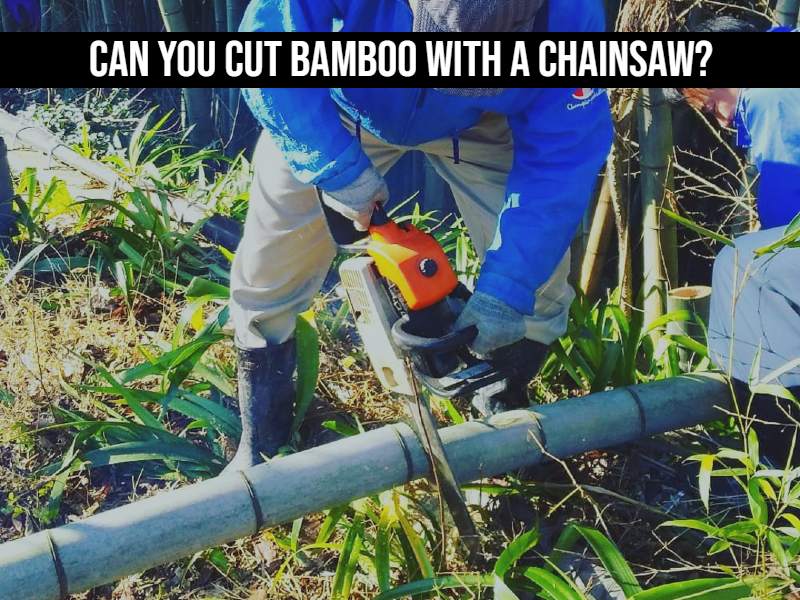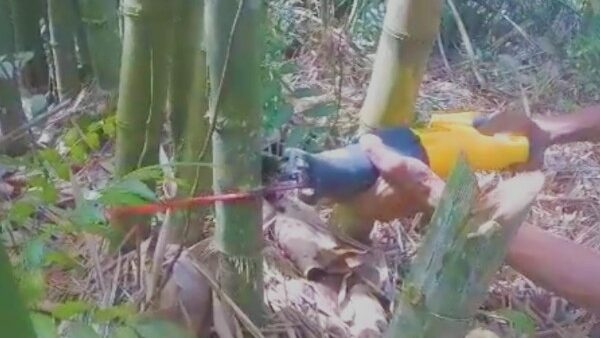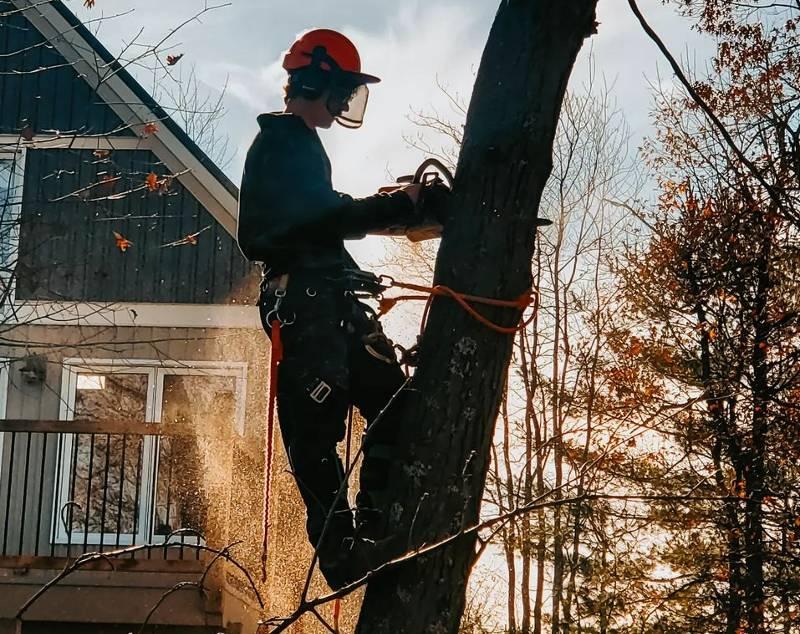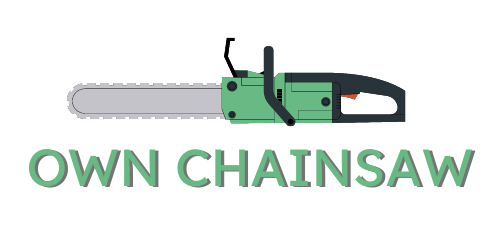Have you ever tried cutting bamboo with a regular saw? If the answer is yes, you know the pain of spending hours hacking away at the tough stalks, only to end up with a jagged and uneven cut.
But, hold on a minute, you might be wondering, “Can you cut bamboo with a chainsaw?”
Yes! A chainsaw can make quick work of cutting through bamboo. Bamboo is an incredibly versatile plant that can be used for a variety of purposes, from building structures to making furniture, and even as a food source. However, not all chainsaws are created equal. You’ll want to check to ensure you have the right equipment and technique to ensure a smooth and safe cutting experience.

Bamboo is notoriously difficult to cut due to its dense and fibrous nature. Using a traditional saw can be time-consuming, frustrating, and even dangerous. A chainsaw, on the other hand, can deliver clean and precise cuts in a fraction of the time.
From choosing the right chainsaw to selecting the proper cutting technique, we’ll cover all of the essential details to make sure your bamboo-cutting experience is as smooth as possible.
How to cut Bamboo with a chainsaw?

Bamboo is a popular material that is used in many different applications, including furniture, flooring, and even as a construction material.
However, cutting bamboo can be a challenging task, especially if you do not have the right tools. One tool that is particularly effective for cutting bamboo is a chainsaw.
1. Choose the Right Chainsaw
Before you start cutting bamboo, it is important to choose the right chainsaw. Ideally, you will want a chainsaw with a long bar and sharp chain that is designed for cutting through dense materials like bamboo. To cut bamboo efficiently and quickly, a gas-powered chainsaw is recommended.
2. Prepare the Bamboo
Prepare the bamboo for cutting once you have your chainsaw. Start by removing any leaves or branches from the bamboo stalks, as these can interfere with the cutting process.
Next, measure and mark the sections of bamboo that you want to cut, using a measuring tape and pencil. By doing so, you will be able to make precise cuts and ensure that the bamboo is cut to the right length.
3. Secure the Bamboo
Before you start cutting, it is important to secure the bamboo in place. Using clamps or other tools, hold the bamboo in place on a flat surface. Alternatively, you can have a partner hold the bamboo steady while you cut it.
4. Make the Cuts
With the bamboo secured in place, it is time to execute the cuts. To do this, start the chainsaw and carefully guide the bar and chain through the bamboo, following the marks that you made in step 2.
It’s important to note that bamboo is hollow in between segments, so it’s best to cut in between them.
Don’t be afraid to let the chainsaw do the work for you – just make sure to use steady, even pressure. It is best not to force the chainsaw through the bamboo, as this can cause the chain to bind and cause kickback.
5. Finish the Cut
After you have cut, turn off the chainsaw and inspect the bamboo to ensure that the cut was clean and even.
If necessary, use a handsaw or other tool to finish the cut and remove any rough or jagged edges. Repeat the process as necessary to cut all of the bamboo sections to the desired length.
6. Protection
Anytime you’re working with a chainsaw, you should wear protective gear to protect yourself from injury. This includes gloves, eye protection, and ear protection.
Bamboo can be particularly tough to cut, so it’s important to wear a heavy-duty pair of gloves that will protect your hands from cuts and scratches.
Video Tutorial:
Is a chainsaw the most suitable thing for cutting bamboo?
While a chainsaw can be used to cut bamboo, it may not always be the most suitable tool. Bamboo is a very durable and fibrous material, and cutting it with a chainsaw can dull the chain quickly.
Additionally, using a chainsaw can create a lot of dust and debris, which can be hazardous to your health if you do not take proper precautions.

A better alternative to relying on a chainsaw for cutting bamboo would be to use a handsaw or a pruning saw.
These types of saws are specifically designed for cutting through wood and other fibrous materials, and they are less likely to produce dust and debris.
They are also safer to use than a chainsaw, especially if you are not experienced with the use of power tools.
Pros of Using a Chainsaw for Cutting Bamboo
1. Speed
One of the main advantages of employing a chainsaw for cutting bamboo is speed.
Chainsaws are designed to cut through wood quickly and efficiently, and they can do the same for bamboo. This means you can get the job done faster, which is great if you have a lot of bamboo to cut.
2. Precision
When cutting bamboo, chainsaws are also very precise tools. Bamboo is a relatively delicate material, and you want to make sure you’re cutting it exactly where you want to. Chainsaws offer a high level of control, which can help you achieve precise cuts.
3. Power
Chainsaws are powerful tools capable of cutting through bamboo stalks easily. With a chainsaw, you can handle even the toughest bamboo-cutting jobs.
Cons of Using a Chainsaw for Cutting Bamboo
1. Safety
Safety is always a concern while using a chainsaw and cutting bamboo is no exception. Bamboo can be unpredictable, and if you’re not careful, you could end up with a serious injury.
Be sure to wear protective gear when handling a chainsaw, and ensure you use it properly.
2. Noise
Chainsaws are incredibly loud, and cutting bamboo with one can be an extremely noisy process. This could be an issue if you’re working in a residential area.
3. Maintenance
To keep chainsaws running smoothly, they need regular maintenance. Maintenance can be time-consuming and expensive, especially if you don’t know what you’re doing.
6 Additional tips for cutting Bamboo
The versatile bamboo plant is used in furniture, flooring, and even as a building material.
The process of cutting bamboo can, however, be challenging if you are not familiar with the proper techniques.
Now we will share some tips on cutting bamboo effectively.
1. Utilize Tape
One of the most common challenges when cutting bamboo is the debris that can fly out between the sticks. This debris can make the cutting process more difficult and messy.
To prevent this from happening, use duct tape to encircle the bamboo sticks. Sap and other debris will not fly out between the sticks. Additionally, the tape will maintain the bamboo sticks in position, leading to a fine cut.
2. Sharpen Your Blade
Using a dull blade to slice through bamboo can be a nightmare. The hard exterior of bamboo can be difficult to cut through even with a sharp blade, so it’s essential to ensure that your blade is sharp.
Investing in a chainsaw sharpener to sharpen your blade after each user is a smart move. It will help you to achieve the best results with minimal hassle.
3. Verify That The Bamboo Is Dry
Cutting bamboo that is damp or moist can be quite challenging. Bamboo absorbs and retains a lot of water, even if it appears dry on the exterior.
This can make the hollow area of the bamboo damp, which can interfere with the cutting process. To achieve optimal results, it’s important to ensure that the bamboo is dry. This can be done by allowing the bamboo to dry in the sun for a few hours before cutting it.
4. Cut Bamboo Outside if Possible
There is a lot of debris produced when cutting bamboo, which can be a messy process. For the sake of avoiding making a mess inside, it is best to trim the bamboo outside.
As a result, you also have enough space to maneuver the bamboo and prevent accidents from happening while cutting bamboo outside.
5. Avoid Cutting Bamboo Near Cables or Other Dangers
Bamboo can grow near power cables, and removing it can be dangerous. Before cutting bamboo, ensure that the area is free from cables, rocks, or other hazards that may interfere with the cutting process. You will be able to cut bamboo safely and hassle-free this way.
6. Clean Your Chainsaw After Use
After cutting bamboo, ensure that you clean your chainsaw thoroughly before putting it away. The chainsaw will not malfunction if debris and sap don’t build up on it. A clean chainsaw also ensures that it lasts longer and performs better.
4 Don’ts when cutting Bamboo
Here are some don’ts regarding cutting bamboo:
1. Don’t Use a Dull Blade
Using a dull blade to cut bamboo can result in a rough and uneven cut. This can make it difficult to use bamboo for its intended purpose.
Additionally, the use of a dull blade can damage the bamboo and cause it to split or crack. To ensure a clean cut, always use a sharp blade when cutting bamboo.
2. Don’t Cut Bamboo During the Wrong Season
Bamboo should be cut during the right season to ensure that it grows back healthy and strong.
Cutting the bamboo at the wrong time of year can lead to stunted growth or even the death of the plant. The best time to cut bamboo is during the winter months during which the plant is dormant.
3. Don’t Cut Bamboo Too Low
It is possible to damage bamboo plants by cutting them too low and preventing them from regrowing properly. To allow bamboo to regenerate, it’s important to leave a few inches of the plant intact when cutting it.
The roots of bamboo can also be exposed if they are cut too low, increasing their susceptibility to pests and diseases.
4. Don’t Forget to Seal the Cut
Bamboo must be sealed after cutting to prevent moisture from entering. In time, bamboo can become weak and rot due to moisture. Cover the exposed area with a waterproof sealant or wax.
FAQs
Can I cut large bamboo poles with a chainsaw?
Yes, you can use a chainsaw to trim large bamboo poles. However, you should use a chainsaw with a longer bar and chain to ensure that you can cut through the entire diameter of the pole.
How do I prevent the chainsaw from getting stuck in the bamboo?
To keep the chainsaw cutting through bamboo, make sure to keep the chainsaw blade moving at a consistent speed and angle. Additionally, you should use a chainsaw blade with large teeth and a low pitch. Finally, try to keep the chainsaw blade perpendicular to the bamboo as you cut, which will help to prevent binding.
Can I cut large-diameter bamboo with a chainsaw?
Yes, you can chainsaw large-diameter bamboo, but a larger chainsaw may be required for thicker bamboo.
Should I cut bamboo when it is wet or dry?
It is best to cut bamboo as soon as it is dry. Wet bamboo can be more difficult to cut and may cause the chainsaw blade to become dull more quickly.

I am Senior Editor and CEO and I have been a chainsaw enthusiast for over 12 years. As a passionate chainsaw enthusiast, I have got a wealth of knowledge and experience with chainsaws, and I am constantly striving to expand my expertise and knowledge. Read More!
